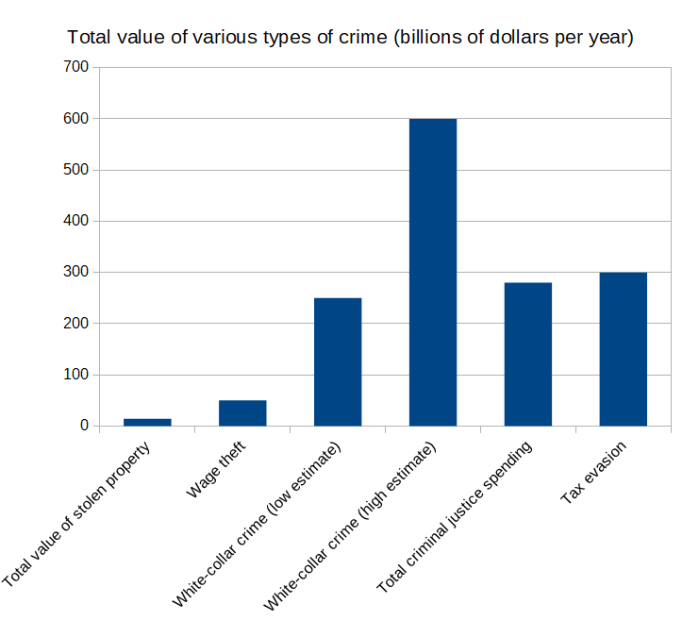Aug 25 JDN 2458722
When you think of “property crime”, you probably envision pickpockets in crowded squares, muggers in dark alleys or burglars breaking into houses. But this is not the kind of property crime that does the most damage—not by a long shot.
Based on FBI estimates, the total economic value of all stolen property (in this conventional sense) is about $14 billion per year. This is less than 0.1% of US GDP.
Wage theft, in which corporations withhold pay that they are contractually obliged to pay, often by misrepresenting hours or not paying overtime rates, is by itself already $50 billion per year.
But this too pales in comparison to the real threat, which is white-collar crime. The direct cost of white-collar crime to the United States has been estimated at between $250 and $600 billion per year. This is about 1-3% of GDP; the average company loses 6% of its revenue to white-collar crime.
This is comparable to, and quite likely more than, the $280 billion total expenditure of all law enforcement and criminal justice in the United States—which has the highest total law enforcement expenditure in the world, and nearly the highest per capita as well.
This is only direct cost, mind you. If you include the indirect costs of all forms of crime, including violent crime, the total cost of all crime in the US rises to about $1.5 trillion. But this figure does not account for white-collar crime. Since the direct costs of white-collar crime are so much higher than those of other forms of crime, it’s quite likely that the indirect costs are higher as well. (Indeed, I think it can be reasonably argued that The Great Recession was an indirect cost of white-collar crime—and it cost about $14 trillion in lost economic output.)
And this is not including the approximately $300 billion per year in tax evasion (mostly in the form of unreported income and overstated charitable contributions).
The graph below compares these figures visually:

Crime pays quite well, as a matter of fact, as long as it’s the right kind of crime.
Our law enforcement system is designed to punish the crimes of the poor, and does so quite relentlessly. But it seems uninterested in punishing the crimes of the rich.
Some of the policies needed to reduce white-collar crime are quite obvious. The first is tax auditing: As the IRS budget has been cut, the number of tax audits has been plummeting, from 1.7 million in 2012 to only 1.1 million in 2017, a decrease of over a third. High-income returns—which are, obviously, where the worst tax evasion happens—have seen an even more precipitous decline in auditing. In 2011, a return over $1 million had about a 12% chance of being audited; now that probability is only 3%.
The budget cuts to the IRS make less than no sense; since 2002, they reduced spending by $14 billion and tax evasion increased by $34 billion. This is the opposite of fiscal responsibility.
Another obvious policy change is to increase spending on the FTC and SEC, the agencies responsible for investigating business transactions and rooting out securities fraud.
Meanwhile, we are actually cutting the SEC budget. This is beyond madness; the total SEC budget is a measly $1.5 billion, and collected entirely from banks, not taxpayers in general. The SEC budget does not contribute to the federal deficit in any way. And think about what madness was to begin with to allocate a budget of only $1.5 billion to regulate an industry with a market value of $26 trillion in this country alone. This is only 0.006%. Since a tax of 0.5% on stock trades, 0.1% on bond trades, and 0.005% on derivatives trades would raise a whopping $220 billion, this means that simply imposing a 0.01% tax on financial transactions would raise enough to increase the SEC budget by an order of magnitude. And this is low enough that it would be felt by basically no one. Frankly if you even care what happens to a single basis point of your rate of return, you are obviously over-leveraged. The difference between making 6.99% and 7.00% per year over 30 years is the difference between turning $1,000 into $7,590.94 and turning it into $7,612.25. That’s a difference of 2% over thirty years.
Simply increasing IRS and SEC audits would not eliminate white-collar crime, of course. It is far too ubiquitous and sophisticated for that. But the fact that we have been cutting these budgets instead of raising them speaks to a much more disturbing truth: These are not the policies of a government that is seriously trying to improve its budget balance. They are the policies of a government that is being corrupted from within, becoming tilted further and further toward the interests of the wealthy.
[…] exceptions prove the rule: The one kind of crime that is utterly rampant in the First World, with impacts dwarfing all others, is white-collar crime—the kind that our police almost never seem to care […]
LikeLike